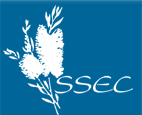
|
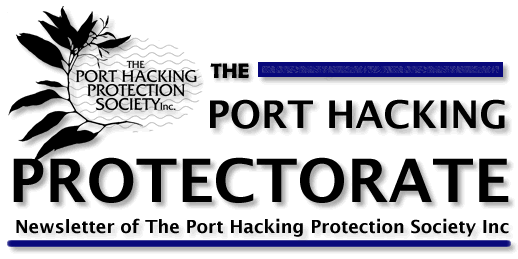 |
November 1999 |
|
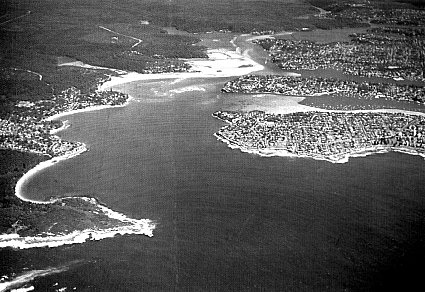 |
Port Hacking: Our Waterway to Manage "With the Hawkesbury River in Sydney's north the subject of sewerage infections and nutrient blooms, the Georges River in the west the conduit for the Macarthur region's siltload, Botany Bay the site for toxic spills and devastative reclamation projects, Parramatta River the place where your fish comes battered with dioxin, and the leprosied Cooks River in the midst of it all the altar piece of our indifference to our city's marine and estuarine waterways, Port Hacking in Sydney's south remains one of the least polluted and most naturally endowed waterways left within a stone's throw from the metropolitan area."
- Quoted from Protectorate 5: Port Hacking's lifetime opportunity.
Editorial Grasping the challenge: Achieving the vision
With a decade of reporting on Port Hacking issues behind us, we decided it was timely to take stock, especially since we are looking to changing our publication format to a webpage. Our review in this issue deals predominantly with the lower catchment of the Hacking - that is with issues around Port Hacking. In the next issue, we will be concentrating more on upper catchment issues.
Certainly, from the perspective of PHPS, the most interesting and rewarding development has been the continuing rise in interest about environmental issues in the community. This is reflected in so many ways: more emphasis on environmental issues in school curriculums; increased support for the plethora of environmental groups; increased State and Federal government legislation to safeguard the environment; establishment of government-funded initiatives and groups such as the National Heritage Trust, Catchment Management Committees, Rivercare and Coastcare; and increased interest and resources by local councils to address environmental problems.
Changes in attitudes are occurring! The question is: Is the change fast enough?
It was problems in the environment that started the movement towards safeguarding it: In the Royal National Park human impact has caused the loss of the Grey Kangaroo, Wallaroo, Potaroo, Eastern Quoll, Tiger Quoll, Koala, Rock Wallaby, Platypus and Brown Phascogale, the Powerful and Sooty Owls are endangered, there are concerns for the Greater Glider and the Mountain Brushtail Possum, fish stocks in the estuary appear to be reducing or at least changing in nature, heads of bays are silting up with land-based sediment and rubbish - some of this rubbish toxic, the conflict for waterways resources becomes ever more pronounced, river banks are being undercut and destabilised, tributaries of the Hacking are choking under the load of nutrient-rich and sediment-loaded urban runoff, water quality in the Hacking can not be assured and in some places is dangerous to human welfare, etc. |
 |
It would be great now to be able to report that as problems became known, we reversed the causes. Instead we find that fifteen, twenty years down the track problems we identified then have got worse! We are still spending a great deal of time discussing what to do about problems and we are spending a great deal of time and energy resisting changes we have to make to the way we recreate, use the foreshore, use the waterway, develop our urban areas, and the like.
But the efforts towards dealing with the issues in a realistic way become ever stronger. In this issue, we highlight many of the initiatives people are taking to come to grips in a realistic and practical way with problems. At the forefront is the Hacking River Catchment Committee, who have been a great asset to Port Hacking, bringing groups together to discuss interests and to find common ground, highlighting research needs and helping to find funding to undertake research. This is not to say that other Authorities have been sitting on their hands. We are eagerly awaiting the Waterways Authority's promised boating plan of management, the NPWS plan of management for Royal National Park, the work of Sutherland Shire Council's newly constituted Port Hacking Management Panel, and the Riverkeeper. We will also be interested to learn the outcomes of NSW Fisheries' current study on macrophytes in Port Hacking and other research projects currently underway.
Stop Press
Moorings off Gunyah
Not more than a couple of months after Waterways Authority placed more moorings off Gunyah Beach, Bundeena (see Protectorate #20), a storm swept several boats off their anchorage and ran them to shore. While boat owners grieved at the thousands of dollars of damage, locals shrugged their shoulders: "Everyone thinks this side of the Port is really calm, but we get some pretty wild storms and Gunyah's no safe place to put a boat." |
Happiness Dashed
by Alan Peterson, Bundeena
Back in June this year we were happy to be granted a mooring licence for Gunyah Bay at Bundeena. The mooring was laid and our 30-foot yacht attached ready for sailing.
However on the 14th of July very rough weather came through with very big seas. We think that combined with an extra low tide the keel hit the bottom. As well slack mooring line wrapped around the keel and the bow-roller gear was bent around at 90 degrees.
All up over $10,000 damage was done to our boat and we have heard that others were damaged also. Also we have noticed that some mooring positions have been changed and wondered what other owner's experience has been? |
|
Coordinating changes for HRCMC
After over four years of dedicated service to the Hacking River Catchment Management Committee (CMC), Libby Rawlingson is taking some well earned leave to dedicate time to her impending role as a mother. Whilst Libby is on maternity leave, Louise Armstrong will be acting in the role of Coordinator for the CMC. Louise has a background in ecological conservation and management and Aboriginal studies and has worked as executive officer to a large University committee, a Coastcare Facilitator (in South Australia) and as the Coastal Projects Officer for the Sydney Coastal Councils Group. Louise is looking forward to working with the CMC and is impressed with their many achievements to date.
WISE - Water Information System for the Environment
An information tool for school students, the general public, scientists and anyone interested!
The WISE project has been developed to compile all the available information on a particular river system, and provide references in an easily accessible format through a database. First cab off the rank in this ambitious project is the Macquarie-Bogan River system. The disk containing that database is now available. The research is well under way for a similar database for the Hacking River system. It will be a welcome resource for schools, universities, communities and researchers. Many organisations are currently contributing to providing the information for this database on the Hacking River system.
Already, hundreds of pictures, historical and new, have been scanned in. Several hours of video footage of the Hacking has already been taken from the air specifically with the database in mind. Piles of books and articles are being carefully studied with main issues identified to enable cataloguing in the database.
Where to camp on the Hacking
Graffiti, rubbish, destruction of vegetation and careless fires along the Royal National Park's Hacking foreshores. These are ongoing and serious management issues for Royal National Park staff. The wanton nature of such vandalism have caused National Parks and Wildlife Service to take a firm stance by limiting camping on the foreshore. There is only one official camping area in the Royal National Park: Bonnie Vale. It is not permitted to camp anywhere else on the Hacking foreshores. There are no limitations on foreshore picnics and walks, but the lighting of fires and disturbance of vegetation is not permitted. If you have any queries, call the Park Visitor Centre on 9542 0648.
Port Hacking: The Lower Catchment
From Audley Weir to the Pacific Ocean, the Hacking catchment is one of the loveliest and most pristine estuaries in the Sydney area. It is the front door to thousands of homes. It is the playground for hundreds of thousands of visitors. It is the dwelling and breeding place of birds, fish, invertebrates, seagrass, mangroves, and other estuarine habitants. It is the area where, in the past decade, the Port Hacking Protection Society has worked most actively, participating in efforts to increase baseline knowledge about the environment, helping to implement programs to increase the sustainability of the estuary, and arguing for the rights of all users of the Port to use its waters and foreshores. |
 |
The Hacking River Catchment Committee has been active in coordinating and promoting some of the activities in Port Hacking. Significant, also, is the role of Sutherland Shire Council, Fisheries, and the Waterways Authority.
Sutherland Shire Council and Waterways Authority have combined efforts and employed a Riverkeeper. The Riverkeeper, who will become an active part of Port Hacking's management will be welcome on-ground support. In addition, Waterways Authority are developing a boating plan of management. Groups and individuals interested in the management of the Port have been asked to submit ideas for this Plan and are eagerly awaiting its draft release. Together with Sutherland Shire Council's revamped Port Hacking Management Panel, we hope that management of the Port is off to a good start in 2000. As readers may remember, one of Port Hacking Protection Society's most consistent refrains is the call for integrated management of the Port. Maybe these latest efforts by the authorities are moving us closer to that goal.
Many of the issues and challenges facing Port Hacking were outlined in presentations given at a recent tour of the Port organised by the Hacking River Catchment Committee. Our resume of the lower Hacking catchment includes information from that tour, as well as other bites of information from other sources.
Boat Tour of Port Hacking
The Port Hacking estuary is a complex system, much more complex than many people think - or would like to think. There are many, many, questions we simply don't have the answer to.
This was a significant point made at the recent tour of Port Hacking organised by the Hacking River Management Committee. On the tour were representatives from various community organisations: business and recreational users of the Port, environmental groups, scientists studying the Port, Sutherland Shire Councillors and Council Staff, and others interested in developments, uses and policies in Port Hacking.
Chief among the presenters was Associate Professor Alberto Albani. As the boat made its way up the estuary, his team brought up sediment samples from the estuary floor and showed sample composition under a microscope. Sediment in the eastern portion of the estuary to the drop-over point at Lilli Pilli is fine grained with local concentrations of shell fragments. In the so called deep hole off Lilli Pilli, the sediment is fine clay and covered in organic matter which live in the relatively oxygen-starved environment 20 metres below sea level. |
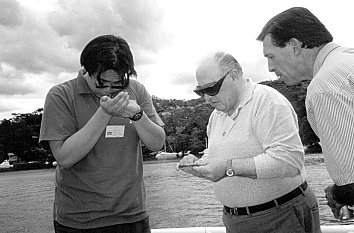 |
Professor Albani and his team have completed a major study of sediment movement and currents of Port Hacking which will provide a foundation for future management strategies concerning issues such as dredging.
Other studies underway are those dealing with the biology of the Port. Several speakers spoke about seagrasses, macrophytes, fish and algae. Ian Suthers from the University of NSW noted that studies in estuaries show that a balance needs to be kept between phytoplankton and zooplankton. Phytoplankton are freely floating, often minute organisms that drift with water currents. They use carbon dioxide, release oxygen, and convert minerals to a form animals can use. Zooplankton - small floating or weakly swimming organisms that drift with water currents and comprise many animals from single-celled to eggs or larvae of crustaceans and other invertebrates, and fish - graze on phytoplankton. Both types of plankton are a food source of birds and animals. When excess nutrients enter a water system, the phytoplankton multiply. The zooplankton multiply in response but at a certain critical stage, the balance is tipped in favour of the phytoplankton and the water system becomes a greenish mess in which animals - and plants - can no longer live.
Ron West, from University of Wollongong, studies seagrasses, not only because they are an important component of estuaries, but because they are an interesting plant in themselves. His talk emphasised the complexity of the biology of Port Hacking, how it varies with changes in salinity, temperature, nutrients and Ph levels. There are a 100 to 200, maybe more, species of fish in Port Hacking, all with their own life cycles and requirements of the Port. Many of these fish use seagrasses for at least a part of their life cycle. He illustrated the different needs of fish by describing the life cycle of several. One eel - the long finned eel - demonstrates the integrated nature of the whole sea, land and estuarine system. This eel travels up into freshwaters and lives a major part of its life upstream then swims back out to sea to spawn one kilometre below sea level in the deep trenches. It relies of good water quality along the whole of its incredible route. And just to illustrate how much pressure current human populations are placing on natural resources - apart from disturbing water quality - Ron quoted that the harvesting of long-finned eel used to be in the order of 30 tons a year.
In the last few years the tonnage has risen to 400 tonnes a year. Other speakers on the tour talked about Port users, from the needs of non motorised craft - windsurfers, fishing row boats, surf boards and rescue boards, recreational paddlers and competitive paddlers, to the needs of motorised craft and swimmers. The pressure on the resources of the Port are growing. Peter Hay from National Parks and Wildlife Service explained that the amount of rubbish, and wear and tear on the foreshore of SW Arm has caused the Service to put a ban on camping and lighting of fires until a management plan is developed. Geoff Hine of the Lilli Pilli Kayak Club pointed out that this low-impact sport has great difficulties in accessing the waterway and finding foreshore space to store canoes. Keith Bowden from the Royal Motor Yacht Club encouraged more dialogue between all Port users to find solutions to competing demands on the waterway.
George Cotis drew everyone's attention to population impacts. Before the 1980s, although population boomed in the Sutherland Shire, the foreshore remained relatively undeveloped - protected by its very steep topography. In the past ten to twenty years, this situation has changed markedly, with wholesale vegetation clearing of foreshore areas and the building of monolithic houses. Sutherland Shire Council has a number of planning instruments that are supposed to control such development, but these instruments have apparently failed - and those on the tour were invited to look at the northern shore of Port Hacking and wonder at the vegetation-and-natural-features to housing ratio. |
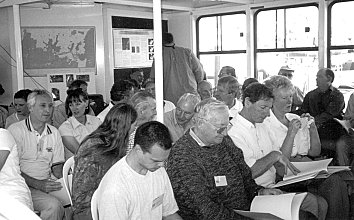 |
Over cups of tea and coffee and slice, tourers pondered on the wealth of information provided. There were others speakers than the ones mentioned above. The underlying message of them all, however, was the same: We have anecdotal information on Port Hacking, and some scientific information, but not enough; we have many, and competing pressures on the waters and foreshores of Port Hacking, and the management of those pressures is not as good as it could be. All of us have a task ahead of us to ensure that Port Hacking remains the wonderful waterway it is today.
Gathering Information About the Hacking River Catchment
The "Point of no Return"?
According to CSIRO Land & Water Division Chief, Dr Graham Harris, scientists have recently achieved a breakthrough in understanding the processes involved in the collapse of coastal ecosystems - and so, better ways to prevent it.
"Estuaries, particularly in populous areas of Australia, have undergone a century-long assault from land clearing, erosion, urbanisation, pollution, nutrient runoff, acid soils, introduced pests, the damming of rivers and dredging of river bars," Dr Harris says. The result is that estuaries, naturally sparkling clear and full of seagrasses and fish, can become turbid, dominated by algae - often toxic - and devoid of native water life.
"Our most important recent advance is the discovery that there is a point-of-no-return, or hysteresis, where the system flips from one type to the other," Dr Harris explains. "Once you reach this point, it becomes extraordinarily difficult, if not impossible, to change the estuary back to the way it used to be. This means it is of the greatest importance to look at what we are doing on the land in the catchments of our bays and estuaries, and to manage our activities far better - before the coastal ecosystem reaches that point."
- Quoted from: NSW Regional Ripples, Marine and Coastal Community Network. Vol6:3, Spring 1999.
Aquatic Biodiversity in the Hacking
By Dr Adam Smith, Office of Conservation, NSW Fisheries
What will Port Hacking look like in 2020? We hope that it will be a clear, healthy waterway enjoyed by humans. and providing a home and feeding place for a diversity of fish, invertebrates and plants. However, there are risks to this future, as the number of people wanting to enjoy the Port increases the pressure on the environment.
It is far from assured that the ecology of the Port will be as healthy in the future as it is today. The biodiversity resources of the Port - the seagrasses, clean water, species of fish, crabs and shellfish - are the foundation for the enjoyment of Port Hacking. Sadly these cannot increase with growing demand. Indeed they are more likely to diminish in the face of this growing user pressure. The most significant management challenge is to protect and enhance what we have. This article highlights some of the approaches that can be taken to protect the biodiversity, and therefore to ensure that in 2020 the Port is at least as healthy and enjoyable as it is today.
State of the Hacking
Port Hacking contains over 200 species of fish and many more invertebrates. Common species of fish include bream, flathead, whiting, tailor, luderick and leatherjacket. Estuarine habitats include seagrass beds, mangroves, rocky reefs, wharf pylons, sand banks and mud bottoms. Freshwater habitats include snags, ribbonweed beds and gravel. The aquatic biodiversity of Port Hacking is generally regarded as healthy, when compared to other urban estuaries such as Botany Bay and Port Kembla. However we lack scientific knowledge about some important aspects of the biodiversity of the Port. Of greater significance is the lack of community education and communication about the importance of aquatic biodiversity (compared to terrestrial biodiversity which people can observe daily). It is easy to find people who love Port Hacking as it is. It more rare to find those who have a well developed understanding of the sensitive natural systems that make it that way. The absence of this knowledge makes it hard for the community to interpret what is happening to the Port, and to press for what is needed to preserve it.
Pressures on biodiversity
Aquatic biodiversity is affected by many human activities, either directly or indirectly. The primary activities that destroy biodiversity are habitat destruction and fragmentation, pollution, introduced species and over-harvesting. It is easy to understand that the destruction of mangroves or seagrasses can cause major harm to the marine life in an estuary. It is less easy to understand that marine habitats are not a series of separate resources. They form part of a system and the health of that system is as much a function of the relationships of diverse habitats as is it the amount of habitat left undamaged. In Port Hacking, seeing some fields of seagrasses on the Southern shore may give the appearance of healthy habitat. What this masks is the changes in the makeup of these grasses over time, and the loss of seagrass habitats on the Northern side. The relationships within the system have changed, and this must have an effect on biodiversity. Specific issues of concern to aquatic biodiversity in Port Hacking include the cumulative impacts of developments on the foreshores, seagrass loss, impacts of dredging, siltation at the heads of bays, point and diffuse sources of pollution, impeded fish passage past Audley weir and harvesting of invertebrates. The loss of strapweed (Posidonia australis) seagrass is of particular concern. This species is very slow to recolonise areas where it has been damaged or removed. There is relatively little of this left on the Northern side of the Port, and the remaining Posidonia beds are easily damaged by anchoring and mooring. |
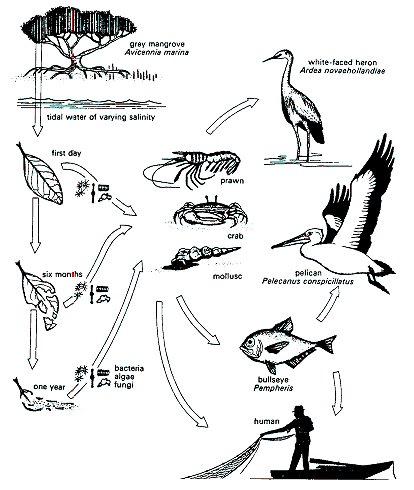 |
Fisheries protection
Responses to reduce the pressure on aquatic biodiversity can occur at different levels of Government (State, local), community groups and individuals. The main tools for managing aquatic biodiversity include legislation, policy, research, education and enforcement. Port Hacking receives a large degree of protection, compared to many other estuaries in NSW waters. The whole of Port Hacking is closed to spearfishing and most of the Port is closed to nets and traps. Gunnamatta Bay is closed to shellfish and bait collecting. The Shiprock Aquatic Reserve is closed to all forms of fishing. An Intertidal Protected Area (IPA), from Bundeena to Simpsons Bay (and recently a fishing closure was extended to Costens Point), prevents the collection of invertebrates. The aquatic habitats in Port Hacking are also protected under the Fisheries Management Act 1994, Fish Habitat Protection Plans and Policy and Guidelines - Aquatic Habitat Management and Fish Conservation 1998. NSW Fisheries has recently acted to protect aquatic biodiversity through negotiation with Sutherland Shire Council and the then Department of Land and Water Conservation, over the disposal of sediment from dredging. In recent rounds of dredging, the sediment was disposed in deep holes in the Port which smothered invertebrates such as worms, crabs and shell. However by working closely with the other authorities, the option of offshore disposal to nourish the beaches of Cronulla was found to be a feasible alternative. |
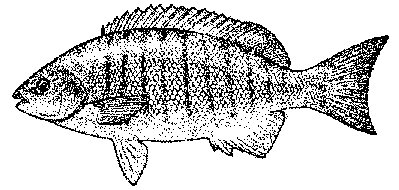 |
What the community can do
The community can help protect aquatic biodiversity by the following actions:
-
By placing a greater emphasis of the state of the health of the aquatic biodiversity of Port Hacking. A state of the environment report for Port Hacking should be implemented, to give the community a better understanding of the underlying health of the estuary.
-
Boaters should ensure that propellers, anchors and moorings do not damage seagrasses. In particular, mooring in Posidonia beds off Jibbon ought be avoided by all responsible boaters.
-
The Hacking River Catchment Management Committee coordinates a biodiversity survey of the Royal National Park. It has proposed to extend this into the waterway. Community volunteers can assist researchers with studies of biodiversity
-
Join a committee to help manage your local area
-
Communicate your concerns and actions to the media and politicians, to raise awareness of biodiversity issues.
For Port Hacking to be a pristine waterway, with rich biodiversity and ample opportunities for enjoyment in ten or twenty years will not require luck. It will require active management and community concern, to ensure that the pressures it is experiencing, as they grow, will not result in the loss of biodiversity and marine habitat. This is a challenge for us all - community and government alike.
Further information: www.fisheries.nsw.gov.au or telephone Adam Smith, Jack Hannan or Brian Hill on (02) 9566 7800.
River Keeper
Sutherland Shire Council and the Waterways Authority have recently appointed a Riverkeeper for Port Hacking.
The purpose of the position will be to:
-
provide a range of customer services that specifically relate to both Waterways and Sutherland Council.
-
enforce regulations and conditions imposed or stipulated by the Authority to ensure that all people using the waterways do so in a safe and environmentally responsible manner.
-
Implement the prioritised actions as determined by the Port Hacking Plan of Management and the Port Hacking Management Panel.
-
Identify gaps in community awareness and provide education on the appropriate use and protection of the river.
-
Develop policy and coordinate programs to involve communities within the rivers catchment to rehabilitate the waterway and its foreshores to benefit its natural, commercial and recreational values.
The position will be financially supported by Sutherland Shire Council with matching in-kind contribution from Waterways Authority ie equipment, hardware and other services.
The Riverkeeper should be out in the Port by December 1999.
Port Use
Many of the issues that concern PHPS are about fairness. Is it fair to impose on those with older boats a requirement to install a pump-out system? Is it fair to spend money on dredging, but not on swimming areas or facilities for kayakers? Is it fair to create exclusion zones? or to expose residents to noise nuisance from power vessels?
Because PHPS has a particular concern for the pressures that can harm either low key activity (swimming, kayaking, surfing or wind surfing, picnicking and residential amenity), or the sensitive environments (seagrasses, intertidal areas, or water quality), we often find ourselves with a different view about what is fair from those whose preferred activities:
-
require the use of public resources;
-
have the potential to impact on the environment;
-
have the greatest potential to deprive other users of that increasingly scarce resource, the opportunities for peaceful enjoyment of a natural waterway.
Tackling the issue
Accepting that the rights of any user is equal to those of any other, it must be that the enjoyment of one low impact user is no less significant than the enjoyment of one higher impact user (and vice versa). If the pleasure for one user causes a loss of pleasure for another, the person achieving enjoyment is doing so at the cost of the other. If the pleasure of one user is achieved at the distress of a greater number there is an unfairness, which ought be corrected. The loss to the many is far greater than the benefit to the one.
A Catchment Management Committee study of foreshore residents clearly shows that uses which require good environmental conditions (swimming, kayaking, etc.) are more common than are those activities which do not require the same pristine conditions. Visitor numbers to Port Hacking also bear out the same message - for the greatest number, it is environment conditions that are the key to their pleasure. "Fairness" and protection of the natural unspoilt conditions, are pretty much aligned in the management of Port Hacking.
An example
Focusing on one of the contentious issues, the use of high speed vessels close to foreshores, one user (or a group in the case of PWCs) can cause distress to a larger number of others who are seeking to enjoy peace and quiet, unspoiled natural conditions, or who are concerned for their or their children's safety in the water. The user creating the noise is taking away the pleasure of the larger number. This is a substantial unfairness, more so because it is the person creating the harm who is getting all the benefit, and the larger number who are unable to do anything to prevent it, who are bearing all the loss.
What is the PHPS position?
It is a sound principle that those who have the capacity to cause a loss to others ought be responsible for preventing it. It is also reasonable to expect that those who have the capacity to reduce the harm take the steps to do so.
Many of the uses which can cause a loss of pleasure for other users require only open water (not unspoilt natural conditions), or they use the water and the Park as a scenic backdrop for activities that do not depend on their natural condition, or merely use the water as a "road" to get from one place to another. They do not depend on being close to the shore, or in quiet natural areas, for their enjoyment. Powered vessels in particular are highly mobile, compared with swimmers, canoeists, fisherpersons or residents, or the biodiversity resources of the waterways. It is easy for them to move to another place, without any significant loss of their amenity.
Requiring that some of these users adjust their use in order to reduce the risks to biodiversity, or to prevent the loss of opportunities for peaceful low impact use valued by others, is not in the least unfair. By any logical analysis, it is about one of the most fair expectations which one part of a community can place on others. And indeed, many of the power boating users of Port Hacking adopt the responsible attitude of enjoying their recreation well away from those whose pleasure will be reduced by the side-effects of that recreation. It is the PHPS position that this informal best practice should be reflected in the way in which uses of the Port are managed. This is not to restrict the use by those who are responsible, but to ensure that those who are less concerned about others are obliged to live up to that best practice. In this way, the responsible users will not have their reputations tarnished by the uncaring, and all users will be able to continue to enjoy Port Hacking in the knowledge that everyone else is acting fairly and responsibly. |
The number of accidents involving power craft on Port Hacking is increasing. The latest one is described in the following letter from Waterways Authority in response to PHPS' request for information on the incident:
Dear Sir,
Thank you for your letter of the 25 October 1999, two PWC operators were jumping waves in the Surf off Bonnie Vale. They were not in each other's sight at all times and at some stage one jumped a wave and collided with the other.
Injuries were sustained to one PWC operator. These injuries were a broken leg and severe facial injuries. He was transported by rescue helicopter to St George Hospital Intensive care unit for treatment. The injured operator under went surgery and is in a stable condition and is able to be interviewed. Engadine Police attended the scene with the assistance of a volunteer rescue organisation.
This was not in an area restricted to such activities. The Water Police are conducting an investigation into the cause of the incident and the Authority is not at liberty to comment on its outcome.
Thank you for your organisations ongoing commitment to safe boating.
Yours sincerely
A/Operations Manager, Botany Bay/Port Hacking |
|
Deeban Spit
Deeban Spit is one of the most prominent features of Port Hacking. The two maps here show how it has moved since 1851. The first map is based on the first hydrosurvey of Port Hacking. |
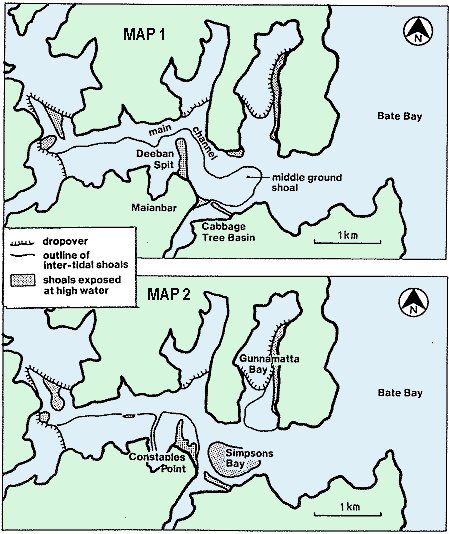 |
Map 2 is from surveys of 1909 and 1911.
The history of movement runs thus: Late in the ninetieth century, an ebb-dominated channel formed south of the middle ground shoal, probably due to storm events. In 1901-2 nearly a third of a million tonnes of sand were dredged from Simpson's Bay to create access to a fish hatchery in Cabbage Tree Basin. This material was dumped onto the middle ground shoal.
By the early 1920s, the middle ground shoal was dividing in two and the westerly portion was being moved by waves and flood tidal currents towards Deeban spit. Simpsons Bay was shoaling and the entrance to Cabbage Tree Basin infilled.
Over the next twenty years the western movement of the middle ground shoal continued. From 1965 to the present, Deeban spit has consolidated its new shape, and has been raised as a result of augmentation by dredged sand. The cycle of spoil dumping onto the middle ground shoal, followed by movement of sand from the shoal to the spit, has also been repeated. Diagramatically, the relative intensity and directions of sand movement within the tidal delta are shown in Map 3. |
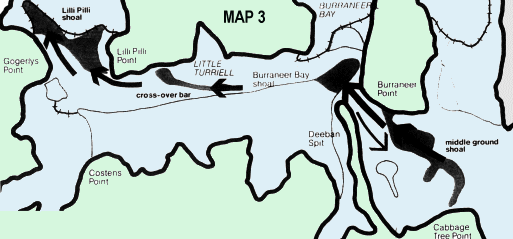 |
Taken from briefing notes prepared by the HRCMC for the participants on it information Port Hacking tour, 6 November 1999.
Evaluating Distributional Changes in Port Hacking Macrophytes
Rob Williams from NSW Fisheries, and one of the speakers on the recent HRCMC-organised tour of Port Hacking, is about to launch a study of Port Hacking's aquatic macrophytes (mangroves, saltmarshes and seagrasses). |
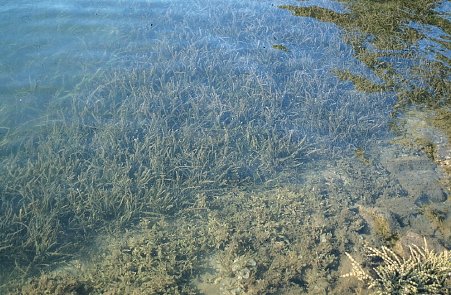 |
Macrophytes provide important nursery habitats for birds and fish. The accumulated impacts of human settlement and urban development, vegetation clearing, stormwater runoff, sewage and septic overflows, all contribute to decreased water quality and sedimentation, which in turn, can impact upon aquatic plant distribution. Recreational boating can also impact on the plants directly as damage can be caused by propellers and boat anchors.
Knowing the health and distribution of Port Hacking's macrophytes can tell us a lot about the general ecological health and priority problems within the Port.
The project aims to define the present boundaries of the main species of macrophytes in the Port Hacking estuary, calculate changes in distribution over time, identify sites of continued loss or gain of one or other type of macrophyte and suggest the likely causes of the changes.
Part of the project will be to train members of the community to monitor plant populations. Results of the project will be publicly available and used to assist with environmental management decisions for the future.
Working in conjunction with NSW Fisheries Research Institute at Cronulla, the Hacking River Catchment Management Committee (HRCMC) received funding assistance for this project from the NHT Coast and Clean Seas program. The program promotes partnerships between the community and government on activities that aim to improve coastal and estuarine water quality, and protect marine species.
For further information on the project, contact Louise Armstrong HRCMC Coordinator on (02) 9895 7769 or Rob Williams at the NSW Fisheries Research Institute on 02 9527 8411.
Biodiversity Program
Rare and endangered species such as the Red-crowned toadlet, Pseudophryne australia and new sponge-like fungus, have been identified by people participating in the Royal National Park and Environs Biodiversity Survey Program.
The biodiversity program started in 1997, in part to study the Royal National Park's regenerative capacity after the devastating 1994 bushfires, but also to gather information on the distribution and abundance of vertebrate and invertebrate fauna over time, to identify the importance of representative plant communities as fauna habitat, and evaluate the dynamics of environmental pressures taking place off-park in surrounding areas.
From ants and fungi, to birds and plants, catchment fauna are being identified and mapped by program participants. The information gathered will be compiled in a comprehensive database of the Park's biodiversity.
The program is managed by the Biodiversity Steering Committee of the Hacking Catchment Management Committee, and includes representatives from NPWS, the University of Wollongong, Helensburgh and District Landcare Group, Sutherland Shire Council, the Hacking River Catchment Management Committee, National Parks Association, Discovery Rangers, Field Study Centre and the community. With over two hundred participants, most volunteers, the program aims to raise awareness of off- and on-park pressures.
Workshops have been held to familiarise participants with survey methods and regular surveying of mammals, birds, reptiles, amphibians, terrestrial invertebrates (particularly ants), freshwater macroinvertebrates, vascular plants, non-vascular plants and fungi.
Each year, results and information about the biodiversity program are displayed at "Springfest", organised at a new venue in the catchment, to provide the wider public with information about the range of efforts, information and people involved in the program.
The CMC considers the biodiversity program to be a huge success and it has been listed as a finalist for the 1999 Metro Pride Awards (Keep Australia Beautiful) and it will be submitted to the Allen Strom Eureka Prize for Environmental Education in the new year.
Peering into the Future
A tale of Patagonian Toothfish and tree loss on the foreshores of Port Hacking
by Paul Martin
Patagonian tooth fish are ancient fish that, like many trees, take a very long time to grow to maturity, and even longer to propagate. They take almost no time to destroy, and once destroyed are hard to replace. There used to be a great number of Patagonian tooth fish, but numbers are diminishing rapidly.
The connection between Patagonian tooth fish and trees is in the process. The process is acted out in the loss of the Toothfish, and, locally, in the deterioration of our water quality, the decline of natural foreshores, the difficulty in finding quiet places away from machine noise, and in the incremental damage to our seagrasses and sensitive environments.
A bountiful and shared resource exists, people live happily enjoying it. The number of people who want to share it increases. For a while this works fine, but then some people realize that they can consume a little more, without any increase in the cost to them. So they catch a few more fish, or cut down the trees on their block (knowing that their view of trees on other people's blocks will not be damaged), or they ignore the catch limit, or put that little bit of rubbish into the water rather than take it home. Perhaps they push the boundaries of the development code, just to increase the amenity of their house or the profit on their development a little bit. After all - their little bit does only a little bit of harm to the commons, and there is no additional cost to them to take that little bit for themselves.
Others look on and realize that the once shared resource is being lost, bit by bit, in incremental steps. Others look on and realize what their neighbours are getting away with, and 'hop in' for their share. After all, "if others are doing it, why should I be the bunny and play by the rules?"
Each action is small in its impact. But collectively they result in the loss of the Commons. Eventually, there is no Patagonian Toothfish, or no native vegetation on the waterfronts, or the water is contaminated with pollution put in a bit at a time.
The Patagonian Toothfish does not swim in our waters, but its threatened state casts a very long shadow over Port Hacking. It ought to make us aware that the common resource is very vulnerable, and that little bits of harm often represent the path to total loss.
What does it take to prevent the tragedy of the Commons? It takes a shared commitment not to see the vulnerable resource lost through ignorance or short sightedness. It requires rules for sharing and protecting the resource that are actively enforced and strongly supported by the community. It may not be too late for the Patagonian Tootfish, and it is not yet too late for Port Hacking. If we care enough we can decide what sort of Port we want to hand on to our children, and we can make this a reality. |
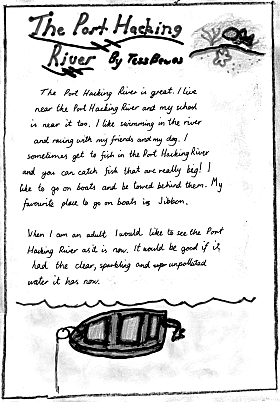 |
Governments can do little to protect the common resource, unless the community drives them to do so, and supports them in enforcing the rules.
Sediment and Pollution in the Port
Improving Urban Streams in Port Hacking Catchment
by Graeme Wickham
Introduction
Keynote speakers at the First South Pacific conference on Stormwater in Urban Stream Environment proclaimed several key factors relevant to the diminished quality of urban streams as aquatic habitat. They particularly emphasised that:
-
Removal of natural tree cover is the single biggest contributor to lower water quality in developed catchments.
-
Streambank vegetation has the most profound impact on water quality of any catchment vegetation.
-
The maximum water quality improvement achievable with current best technology cannot re-instate stream quality lost as a result of clearing.
They agreed that urban streams suffered their greatest degradation as a result of:
-
"Flow improvement" from formalising drainage in kerb and guttering, straightening and smoothing flow channels, piping stormwater underground, removing snags; and
-
Widespread increases in the areas of impervious hard surfaces on roads, roofs and parking lots.
|
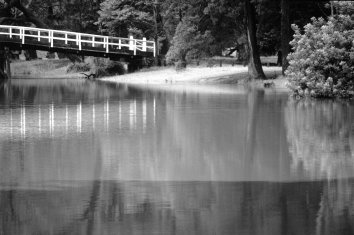 |
The clearest indications of poor stream habitat were seen to be:
-
A loss of deep cool pools and cascading riffle zones
-
An increased incidence of streambank erosion, turbidity and sedimentation
-
Consistently higher water temperatures
-
Higher concentrations of soluble salts including heavy metals
-
Lower oxygen levels
-
Less persistent base flows, with more frequent fluctuations between instream "flood" and "drought" conditions.
The Port Hacking Situation
These factors clearly characterise many of the small streams that make up the catchment of Port Hacking, particularly those within the more highly urbanised zones between Sutherland and Cronulla and residential areas around Engadine and East Heathcote. As such they demonstrate a need for us:
-
To appreciate that while many of our urban streams are so seriously degraded that they can never be fully re-instated to their natural condition, they should be urgently rehabilitated.
-
Take every opportunity within the whole catchment and every means at our disposal to protect and enhance what remains of our urban stream values.
-
Mount a coordinated and sustained, community - wide effort (forever) if we wish to reverse, or even slow the continued decline in local stream quality.
What we can do
It is important that the whole community is aware of the situation confronting local streams and is motivated to:
-
Become involved with catchment-wide initiatives to improve stream quality by influencing organisations like CMC, Councils, State agencies and statutory authorities to take a "total catchment" view of their water quality and land management responsibilities.
-
Participate in important volunteer programs like Bushcare, Streamwatch, Coastcare and Landcare to remove rubbish, replace catchment flora, monitor creek quality or manage floral diversity in wetlands - amongst other things.
-
Work with authorities on approved programs to improve urban streams in local reserves and parks (or on private lands) by re-instating some of the values lost as a result of development of their catchments.
The community's contribution is to diminish or reverse the impacts of urbanisation mentioned in my introduction. Initiatives include:
-
Landscaping their yards with native trees, shrubs and grasses.
-
Creating porous driveways and shallow surface depressions that hold stormwater for a short time.
-
Collecting roof water to irrigate their yards.
-
Reducing weediness in the catchment by eliminating potential weeds from their garden planting.
-
Replacing foreign vegetation with suitable local native species.
-
Establishing suitable native water plants in shallow streams.
-
Planting shading trees near water holes and pools.
-
Removing urban sediment and re-creating deep pools, meanders and shallow cascades (riffles).
-
Stabilising soft streambanks with reinforced native grasses.
-
Eliminating mosquito habitat and discouraging pest animal species like carp, domestic ducks and geese.
The Upper Catchment
Latest developments in the Hacking River Catchment
by Tim Tapsell
Australia`s oldest and seemingly eternal conservation battle to save Royal National Park reached a volatile point in 1985 with the prospect of a Helensburgh Plan for massive urban expansion in the headwater of the Hacking River. What followed was an intense public debate on the planning wisdom of locating houses and factories on a major tributary considering the adverse impacts of the existing town on the entire Hacking environment. Robert Webster, then Coalition Minister for Planning, rezoned the last of the rural lands to 'Environment Protection". A great public victory.
Still, developers never lie down and some are still attempting to have the Environment Protection zoning removed and start the whole development-versus-environment battle all over again. In the meantime we continue with the existing problems. The most serious for the upper catchment are the responsible management of a coal mine, a Wollongong City Council Tip, an abandoned and eroding sand mine, and stormwater from the Helensburgh township. |
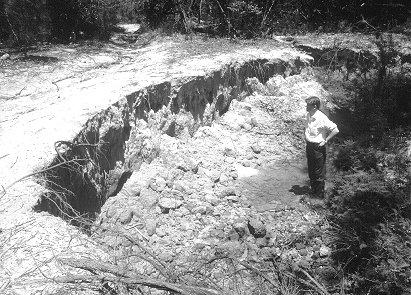 |
A new threat has emerged with the State Govt. considering piping more of Wollongong`s sewerage to Cronulla, via the upper catchment. This means importing millions of litres of sewerage, with its overflows and manholes (unofficial overflows), to an already stressed system. In its ten-year life, the Helensburgh line has had three major breaks resulting in mass discharges into a protected river. No warnings were given to users downstream.
All licences to discharge pollution into the Hacking River should be phased out. The coal mine holds the only such licence and can improve its discharges to negate the need for licence. Given the new relaxed licence for the coal mine, and the proposed licence for Sydney Water, it appears the State governments solution to pollution is to legalise it. More applications for licence to pollute will follow.
What Our Kids Say... |
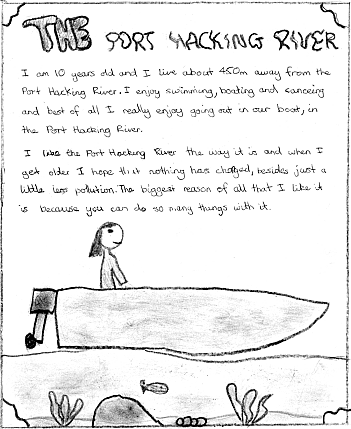
 |
| top of page |
|
